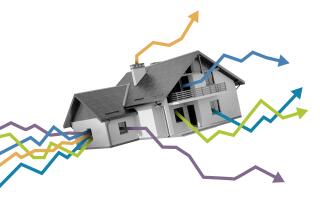Southland Home Prices Up Slightly
- Share via
The long-struggling Southern California housing market has finally staged a modest turnaround, with home prices this year having risen or remained stable across much of the region.
The latest evidence of the comeback came Tuesday with figures showing that the median sales price in Los Angeles County rose nearly 5% in May to $172,000. That helped push the median price gain for a home sold in Southern California to 2.5% for the first five months of the year compared to the same period last year, according to DataQuick Information Systems, a real estate research firm.
During the first five months of the year, which includes most of the busy spring home buying season, the median price rose 4.2% in Ventura and San Diego counties while remaining flat in Orange County, which enjoyed a boom last spring. Although the number of home sales has been strong for quite some time, home prices, the critical measure of the market’s health, have been slow to rise.
However, in each of the last five months, the Southern California median price has risen steadily in one of the market’s strongest showings of the decade. In addition, the number of Southern California home foreclosures, which depress the prices of neighboring properties, have dropped sharply from last year’s high levels.
“It’s not what anyone would call a ‘hot market,’ ” said UCLA economist Tom Lieser, but “you see more activity and houses seem to not stay on the market for very long.”
However, Lieser and other housing observers note that the recent turnaround has yet to reach many areas of Southern California, including regions such as the Antelope Valley that were overbuilt during the 1980s boom. In some sections of Lancaster, the median home price dropped 12% in the most recent three months compared to the same period last year, according to DataQuick.
However, the modest recovery taking hold through much of Southern California is welcome news for thousands of homeowners who have suffered through seven years of a sluggish market. Many who purchased homes during the late 1980s and early 1990s have seen their equity evaporate during the slump. Southern California prices on average are still down about 15% compared with the most recent peak in 1991.
The region’s real estate market has lagged well behind the national real estate market, which rebounded several years ago, and Northern California, which has come roaring back thanks to the booming Silicon Valley.
A recovery would be a boost to the Southern California economy, which has rebounded from the severe recession of the early 1990s largely without the aid of the housing market. Higher housing values would increase the equity as well as the confidence and spending of millions of homeowners.
A combination of the resurgent economy, low mortgage rates and a pent-up demand for housing have helped boost prices this year. In addition, the net outflow of residents for other parts of the country has slowed and is expected to turn around next year, creating even more demand for housing.
Competition among home buyers has become intense in some areas, and a few agents on the Westside have started to pay for hard-to-find listings in choice neighborhoods.
“There is a ton of buyers and nothing to show them,” said Westside agent Linda Semon.
Starting in February, schoolteacher Erin Yoon looked at a house nearly every day for three months across the Westside only to have those in her price range--about $250,000--snapped up by rival bidders. So when her agent told her of a Brentwood condominium that had just been listed, Yoon rushed over to see it that afternoon. She made an offer a few hours later, before her fiance even had a chance to look at the unit.
“We really lucked out,” said Yoon, 27, who moved into her new home this month. “It’s pretty tough out there.”
Attorney John Hunckey recently paid more than $1 million for a four-bedroom Brentwood home after a frustrating search in which two previous offers on other homes had been topped. Despite paying more than he wanted, Hunckey, 44, was glad to be spared the losing-bidder experience.
“We felt we paid more than we should have,” Hunckey said. But, “we probably would have had to do the same thing on another house.”
Other areas that have reported sharp increases in sales activity and prices include Corona del Mar, where the median sales price has risen more than 15% since last year, and sections of Torrance, where the median has climbed about 17%.
In the San Fernando Valley, prices remain soft but have firmed up enough in some cases to force Northridge agent Stephanie Vitacco to change her standard advice. After years of telling sellers to chop prices, Vitacco in some cases is now telling clients to be a bit more aggressive on prices.
Still, most of the demand in her market is for low-end, $150,000, two-bedroom San Fernando Valley ranch houses popular with first-time buyers. “They are like Toyotas. Everybody wants one,” she said.
Despite this year’s rise in median prices, home values remain too low for many Southern California homeowners to break even on the sale of their houses, let alone make a profit.
On a recent visit to a condominium development in Rancho Santa Margarita, Orange County real estate agent Joan Wilson found many owners eager to sell but trapped by a lack of equity. Most had bought their units for $185,000, which is $40,000 more than current sales prices in the area.
“They say they need to wait for the market to catch up with them,” Wilson said. She estimates that will happen in 2000.
Antique dealer Lisa Chandler has followed the route of many area homeowners. Instead of selling her former Granada Hills home at a massive loss, Chandler, who moved to Malibu, rented out the hillside property after receiving no offers on the house listed at $329,000.
“At least it is not sitting there empty,” she said.
Despite the turnaround, Southern California homeowners should not expect a return of the housing boom that sent home prices soaring more than 20% a year during the late 1980s. Now, a decade later, a slower-growing and older population will hold down demand. In addition, few buyers today expect to reap a windfall in Southern California real estate, leaving little incentive to pay a premium price for property.
“We are on the right track, but people should not get overly excited,” said Esmail Adibi, director of the Anderson Center for Economic Research at Chapman University. “‘People have to lower their expectations about [how much money they will make] when they turn around and sell.”
More to Read
Inside the business of entertainment
The Wide Shot brings you news, analysis and insights on everything from streaming wars to production — and what it all means for the future.
You may occasionally receive promotional content from the Los Angeles Times.









